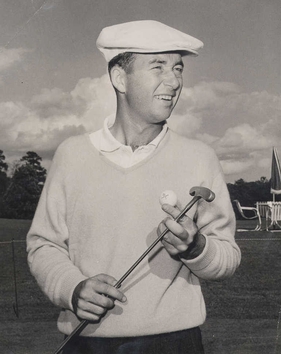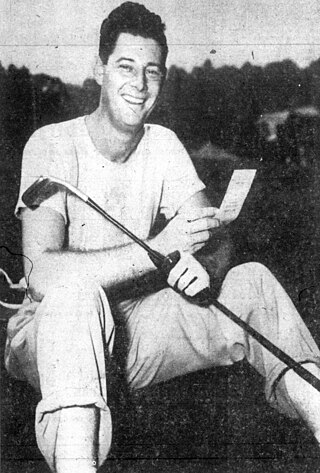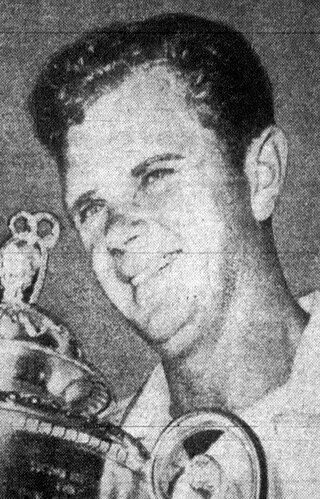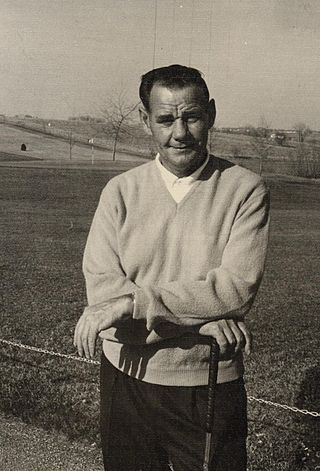
Samuel Jackson Snead was an American professional golfer who was one of the top players in the world for the better part of four decades and widely regarded as one of the greatest players of all time. Snead was awarded a record 94 gold medallions, for wins in PGA of America Tour events and later credited with winning a record 82 PGA Tour events tied with Tiger Woods, including seven majors. He never won the U.S. Open, though he was runner-up four times. Snead was inducted into the World Golf Hall of Fame in 1974.

Jack William Nicklaus, nicknamed "the Golden Bear", is an American retired professional golfer and golf course designer. He is widely considered to be one of the greatest golfers of all time. He won 117 professional tournaments in his career. Over a quarter-century, he won a record 18 major championships, three more than second-placed Tiger Woods. Nicklaus focused on the major championships—the Masters Tournament, U.S. Open, Open Championship and PGA Championship—and played a selective schedule of regular PGA Tour events. He competed in 164 major tournaments, more than any other player, and finished with 73 PGA Tour victories, third behind Sam Snead (82) and Woods (82).

William Ben Hogan was an American professional golfer who is generally considered to be one of the greatest players in the history of the game. He is notable for his profound influence on golf swing theory, inventing the idea of practicing golf and his ball-striking ability.

John Joseph Burke Jr. was an American professional golfer who was most prominent in the 1950s. The son of a professional golfer, Jack Burke Sr., he won two major titles, both in 1956, the Masters and PGA Championship, and is a member of the World Golf Hall of Fame.

James Newton Demaret was an American professional golfer. He won 31 PGA Tour events in a long career between 1935 and 1957, and was the first three-time winner of the Masters, with titles in 1940, 1947, and 1950.

John Byron Nelson Jr. was an American professional golfer between 1935 and 1946, widely considered one of the greatest golfers of all time.

Kenneth Paul Venturi was an American professional golfer and golf broadcaster. In a career shortened by injuries, he won 14 events on the PGA Tour including a major, the U.S. Open in 1964. Shortly before his death in 2013, Venturi was inducted into the World Golf Hall of Fame.

Emmett Cary Middlecoff was an American professional golfer on the PGA Tour from 1947 to 1961. His 39 Tour wins place him tied for tenth all-time, and he won three major championships. Middlecoff graduated as a dentist, but gave up his practice at age 26 to become a full-time Tour golfer.
Curtis Northrup Strange is an American professional golfer and TV color commentator. He is the winner of consecutive U.S. Open titles and a member of the World Golf Hall of Fame and Virginia Sports Hall of Fame. He spent over 200 weeks in the top-10 of the Official World Golf Ranking between their debut in 1986 and 1990.
The men's major golf championships, commonly known as the major championships, and often referred to simply as the majors, are the most prestigious tournaments in golf. Historically, the national open and amateur championships of Great Britain and the United States were regarded as the majors. With the rise of professional golf in the middle of the twentieth century, the majors came to refer to the most prestigious professional tournaments.

Lloyd Eugene Mangrum was an American professional golfer. He was known for his smooth swing and his relaxed demeanour on the course, which earned him the nickname "Mr. Icicle."

Gene Alec Littler was an American professional golfer and a member of the World Golf Hall of Fame. Known for a solid temperament and nicknamed "Gene the Machine" for his smooth, rhythmical swing, he once said that, "Golf is not a game of great shots. It's a game of the best misses. The people who win make the smallest mistakes."

Thomas Henry Bolt was an American professional golfer. He did not join the PGA Tour until he was in his thirties, but he went on to win 15 PGA Tour titles, including the 1958 U.S. Open. He played in the Ryder Cup in 1955 and 1957.

Michael Souchak was an American professional golfer. He won fifteen events on the PGA Tour in the 1950s and 1960s and represented the United States for the Ryder Cup in 1959 and 1961.

Edward Stewart "Porky" Oliver, Jr. was a professional golfer from the United States. He played on what is now known as the PGA Tour in the 1940s and 1950s.

Walter E. Burkemo was an American professional golfer, best known for winning the PGA Championship in 1953.

The 1957 Masters Tournament was the 21st Masters Tournament, held April 4–7 at Augusta National Golf Club in Augusta, Georgia. This was the first Masters played with a 36-hole cut; 101 players started and forty made the cut at 150 (+6).

The 1960 Masters Tournament was the 24th Masters Tournament, held April 7–10 at Augusta National Golf Club in Augusta, Georgia. Arnold Palmer birdied the final two holes to win by one stroke over runner-up Ken Venturi.
The 1955 U.S. Open was the 55th U.S. Open, held June 16–19 at the Lake Course of the Olympic Club in San Francisco, California. In one of the greatest upsets in golf history, Jack Fleck, a municipal course pro from Iowa, prevailed in an 18-hole playoff to win his only major title and denied Ben Hogan a record fifth U.S. Open.

Robert Nelson Fry was an American professional golfer instrumental in the development of golf in the Iowa and Illinois area.
















